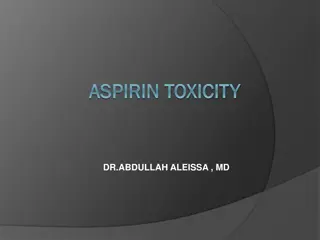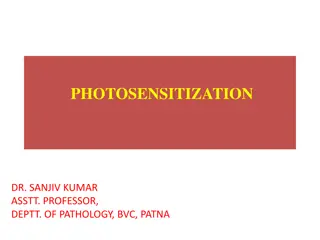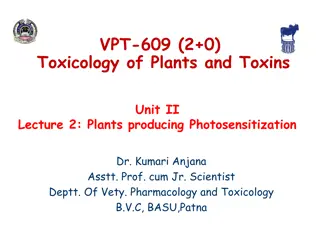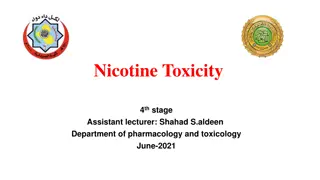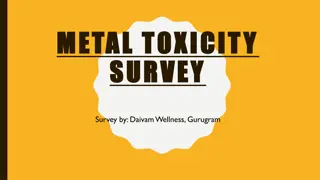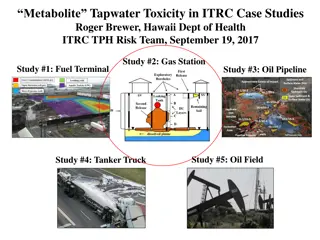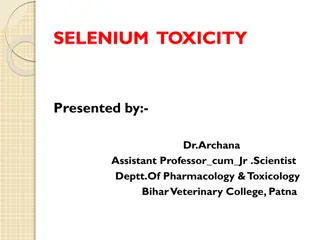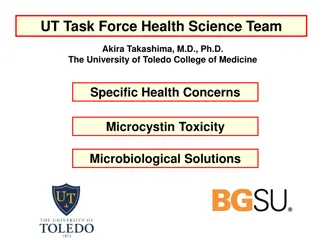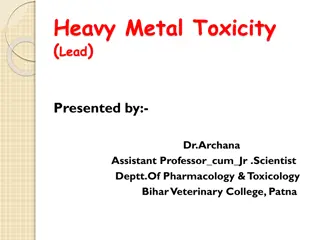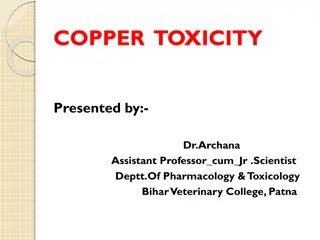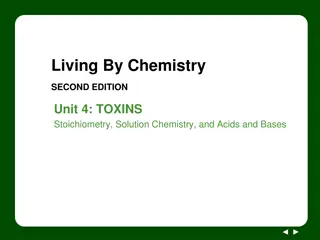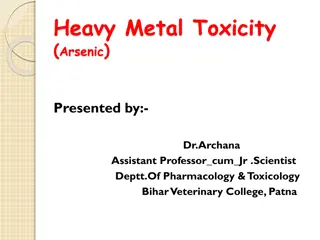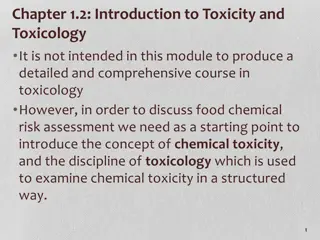Understanding Photosensitization in Plants: Causes and Toxicity
Photosensitization in plants can lead to abnormal skin sensitivity to sunlight, caused by the presence of photodynamic agents in the skin and peripheral circulation. Primary and secondary photosensitization are common, with various plants and toxins contributing to liver damage and biliary occlusion. Lantana camara poisoning is a significant concern, particularly for livestock, due to its toxicity. Understanding the toxic principles of plants like Lantana camara is essential for managing risks to susceptible species.
Download Presentation

Please find below an Image/Link to download the presentation.
The content on the website is provided AS IS for your information and personal use only. It may not be sold, licensed, or shared on other websites without obtaining consent from the author. Download presentation by click this link. If you encounter any issues during the download, it is possible that the publisher has removed the file from their server.
E N D
Presentation Transcript
Plants Producing Photosensitization Photosensitization: Abnormal sensitivity of the light pigmented areas of skin to sunlight due to presence of photodynamic agent(s) in the peripheral circulation and skin. Secondary (Hepatogenous) Photosensitization Primary Most Frequent Photosensitization Photodynamic agents/Photodynamic metabolite Polyphenolic pigments Phylloerythrin bacterial breakdown product of chlorophyll Absorbed from GIT Under skin through circulation and reacts with UV light Hypericum perforatum (Saint John s wort) Fagopyrum esculentum (Buckweed) Ammi majus (Bishop s Weed) Trifolium spp. , Medicago spp., Erosium spp., Brassica spp. Accumulate in peripheral blood: Photosensitization Microcystis spp. (Blue green algae ) Tetradymia glabrata (Horse brush) Lantana camara (Lantana) Sporidesmin (Moulds)-Icterogenic Dermatitis/Photosensitization
Secondary (Hepatogenous) Photosensitization Plants causing biliary occlusion Plants causing Liver damage (Pyrrolizidine alkaloids) Tribulus terrestris (Puncture vine) Panicum colaratum (Klein grass) Agave lecheguilla (Agave) Lantana camara (Lantana) Senecio spp., Crotolaria spp., Heliotropium spp. Saponins (form crystals): Inflammation and obstruction of bile duct Bioactivated to Pyrroles by Mono-oxygenase system Phylloerythrin: Accumulate in blood stream leads to photosensitization Alkylate DNA, impairs cell division in hepatocytes Hepatocellular necrosis/Hepatomegaly/karyomegaly: Death Pigs are most susceptible Pyrrolizidine alkaloids: Carcinogen/mutagen/teratogen/abortifacient
Lantana camara poisoning (Shrub once grown as garden ornamentals, major weed across all states and territories of Australia); Alien weed Another variety, Lantana montevidensis Red-yellow, orange-pink and white depending location and plant maturity. Lantana is mostly seen in coastal and sub-tropical areas however it can survive in dry areas as well on the Treated as poisonous to stock Red flowered varieties most toxic White and pink flowered can also be highly toxic
Susceptible Species Cattle, sheep, goats and camelids are affected by the plants. Lantana is not toxic to humans unless berries are ingested. Lantana poisoning occur when animals are introduced to an area where toxic forms of lantana grows or during droughts when other feed sources are scarce
Toxic principles of Lantana camara Lantadenes (Polycyclic triterpenes) (Sheep is most susceptible) Major lantadenes Icterogenins Olenonic acid Oleanolic acid Carmarinic acid Trans fused cyclic lactones Lantadene A Lantadene B Lantadene C Lantadene D Minor lantadenes Reduced lantadene A Reduced lantadene B
Mechanism of Toxicity of Lantana camara Ingestion of plant Three factors: Photodynamic substance UV light Light pigmented skin Photodynamic substance after absorption from GIT enters circulation Energised by certain wavelength of UV light and molecule attain high energy state Photodynamic agents return to lower energy state and releases energy- transferred to receptor molecules and initiate chemical reaction in skin Tissue injury (by production of ROS) Damage cell membrane and alters cell membrane permeability Release of histamine (mast cells) Inflammatory reactions: Erythema, edema, vesicles, pruritis, cellular necrosis, sloughing off of affected skin
CLINICAL SIGNS and SYMPTOMS OF LANTANA POISONING Signs of lantana poisoning depend on the type of lantana consumed, how much of it and the intensity of sunlight. Acute signs appear with in 24 hours. Signs include: Depression, loss of appetite , Photophobia Constipation, frequent urination Jaundice (yellow discolouration) of the insides of the eyes, mouth and vulva Drooling and weeping eyes (Conjunctivitis), Skin Sensitivity to sunlight Reddening and inflammation of unpigmented (white) skin; muzzle may become inflamed, moist, ulcerated and very painful (pink nose) and slough (fall off) Severely affected animals may have a short period of diarrhea with black strong smelling faeces Death may take between 2d-3wks depending on the severity
DIAGNOSIS Diagnosis is based on the animal s access to lantana and clinical signs shown (e.g. jaundice). Calves poisoned by lantana stop eating and become weak and depressed Cattle may become sun sensitive and their skin may blister after eating lantana Jaundice (yellow discolouration) of eye Photo-sensitisation
POST MORTEM FINDINGS Yellow discolouration of tissues (jaundice) Hard, dry, mucus-covered faecal masses in large intestine Dry, undigested plant material in the rumen Swollen and discoloured (yellow to orange) liver Swollen gall bladder Swollen and pale kidneys that turn green when exposed to air and cutting Ulcerated cheeks, muzzle, nostrils, tongue and gums (in severe cases in cattle) Post-mortem changes enlarged gall bladder and yellowing of all tissues
TREATMENT Unless treated quickly and effectively, animals may die within a week of ingesting the plant. - Move animal to a lantana free area - Place in the shade at all times due to sun sensitivity - Early diagnosed animals may be drenched with activated charcoal to reduce toxin absorption - Provide fresh water and good quality hay at all times - Give oral electrolytes or intravenous fluids if animal is severely dehydrated - Antibiotics and anti-inflammatories
Effective treatment may include: Intravenous fluids and encouraging the animal to eat Treating skin damage with antibiotics and sunscreens; other drugs can provide relief but are available only on veterinary prescription Drenching with a slurry (2.5 kg activated charcoal in 20 litres of electrolyte replacement solution for cattle; 500 g in 4 litres for sheep and goats)
HOW TO PREVENT LANTANA POISONING Follow these key points to prevent your animals from being poisoned by lantana. -Treat all lantana as being poisonous -Keep your property lantana free weed control is paramount -Ensure stock have adequate feed at all times -Never put new/young stock in areas where lantana is present - Act quickly if poisoning is suspected



